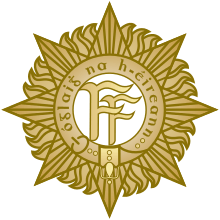Cathal Brugha Barracks
| Cathal Brugha Barracks | |
|---|---|
| Dún Chathail Bhrugha | |
| Dublin, Ireland | |
_(2).jpg) | |
 Cathal Brugha Barracks Location within Ireland | |
| Coordinates | 53°19′37″N 6°16′09″W / 53.32702°N 6.26906°WCoordinates: 53°19′37″N 6°16′09″W / 53.32702°N 6.26906°W |
| Type | Barracks |
| Site information | |
| Operator |
|
| Open to the public | Partial (Barracks museum and archives are open to public at certain times)[1][2] |
| Site history | |
| Built | 1810 |
| Events | 1916 Easter Rising, Irish War of Independence |
| Garrison information | |
| Current commander | Brigadier General Michael Finn[3] |
| Garrison | 2 Brigade of Irish Army |

Cathal Brugha Barracks (Irish: Dún Chathail Bhrugha) is an Irish Army barracks in Rathmines, Dublin. A key military base of the Irish Defence Forces, it is the headquarters of 2 Brigade,[4] and houses the Military Archives of the Department of Defence.
History
The barracks was originally constructed between 1810 and 1815, and named Portobello Barracks for the area in which it was sited. (When Sir Francis Drake looted the city of Portobelo, Panama, died and was buried at sea in its harbour, many places in England and Ireland were commemoratively named Portobello – including part of Rathmines in 1696. The nearby canal bridge and the area became known as Portobello and thereafter, the barracks.)[5]
Originally designed as a cavalry barracks, it saw some development along these lines, with additional land being purchased, and the addition of a church (1842) and canteen block (1868).[6]
During the 1916 Easter Rising, and the Irish War of Independence, British Troops from the barracks were involved in actions throughout Dublin. During this time, three journalists, including the pacifist Francis Sheehy-Skeffington, were murdered outside the barrack guardroom. The Royal Irish Rifles company commander Captain Bowen-Colthurst, who ordered the shootings, was controversially adjudged "insane" at the subsequent inquiry and court-martial.[7]
On 17 May 1922 Irish troops took possession of the Barracks, and it became the National Army's Headquarters under General Michael Collins.[6]
In 1952 it was renamed for Cathal Brugha, who was a leader during the 1916 rising, Minister for Defence in the First Dáil, and who lived locally for a time. Cathal Brugha an IRA man was gunned down by the National Army on O'Connell street during the Battle of Dublin.[8]
Current use
Since the end of the Irish War of Independence, the barracks has housed units of the Irish Defence Forces, and has more recently been developed as a result of the force's reorganisation. It became the Eastern Command HQ (again) in 1994. Following the 2012 reorganisation of the army,[9] the barracks became headquarters of the reorganised 2 Brigade.[4]
Cathal Brugha Barracks houses the following units:[10]
- 2 Brigade Headquarters
- 7 Infantry Battalion
- 2 Brigade Cavalry Squadron
- 2 Brigade Field CIS Company
- 2 Brigade Military Police Company
- 2 Brigade Transport Company
- 2 Brigade Ordnance Company
- 2 Brigade Training Centre
- Army School of Music and No 1 Army Band
- (Plus reserves units such as a CIS Radio Platoon and the Dublin Unit of the Naval Service Reserve (DUNSR))[10]
Literary references
He had a good slice of luck, Jack Mooney was telling me, over that boxing match Myler Keogh won again that soldier in the Portobello barracks. By God, he had the little kipper down in the county Carlow he was telling me— Ulysses, Chapter 2, Lestrygonians episode, James Joyce
References
| Wikimedia Commons has media related to Cathal Brugha Barracks. |
- ↑ "Cathal Brugha Visitor Centre | Defence Forces Museums | Info Centre | Defence Forces". Military.ie. Retrieved 30 November 2012.
- ↑ "About Military Archives". Militaryarchives.ie. Retrieved 30 November 2012.
- ↑ "GOC 2 E Bde | Brigade Commanders | General Staff | Info Centre | Defence Forces". Military.ie. Retrieved 30 November 2012.
- 1 2 "Organisation of the Army – 2 Brigade". Irish Defence Forces. Retrieved 13 December 2012.
- ↑ "Sir Francis Drake's body 'close to being found off Panama'". BBC. 25 October 2011. Retrieved 9 October 2016.
- 1 2 "Cathal Brugha Barracks". Dublin City Council. Retrieved 9 October 2016.
- ↑ "Royal Commission on the Arrest and subsequent treatment of Mr. Francis Sheehy Skeffington, Mr. Thomas Dickson, and Mr. Patrick James McIntyre: Report of the Commission, presented to both houses of Parliament by command of His Majesty". London: Darling & Son. 1916. Retrieved 9 October 2016.
- ↑ Quinn, James (2009). "Brugha, Cathal (National Archives of Ireland webpage)" (PDF). Dictionary of Irish Biography. 1: 951–954. Retrieved 8 July 2015.
- ↑ Irish Defence Forces Press Office (30 November 2012). "Ceremonial Stand Down Parade of the 4th Western Brigade". Official Defence Forces Website. Retrieved 13 December 2012.
- 1 2 "Military.ie - Contact Us - Cathal Brugha Barracks, Dublin". Official Defence Forces Website. Retrieved 10 November 2014.
